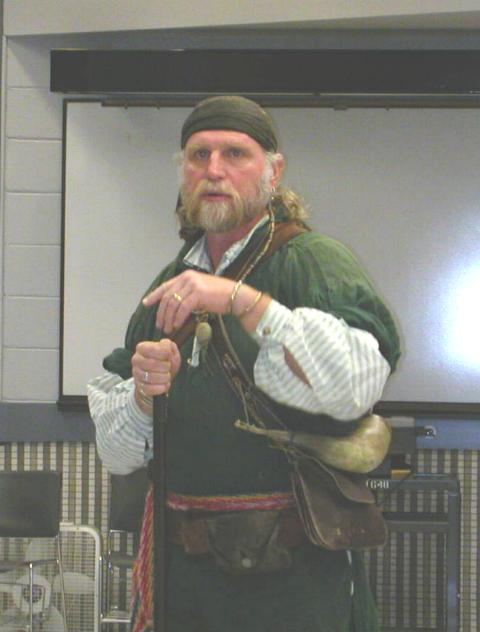Lewis & Clark
Expedition
Grady Manus as George Drouillard

Interpreter Grady Manus, in costume (above) and speaking in first person as George Drouillard, the chief hunter and interpreter for the Lewis and Clark expedition, delighted about 100 audience members at the October 28, 2004 "Sperry-Galligar Audubon " meeting. Speaking with an accent and dressed like Drouillard, Grady Manus was so convincing that every member in the audience felt they were being addressed by Drouillard himself. Manus (or was it Drouillard?) talked about the tasks and dangers involved on the Lewis & Clark expedition and later addressed question from the audience in Drouillard's accented voice so convincingly that everyone thought it was the Drouillard himself. The audience was totally silent throughout and so immersed that when he stepped out of character they felt somewhat betrayed. Thank you Grady (or is it George) for an experience not to be forgotten.
Dr. David Gordon &
Jim Ausemus.
Dr. David Gordon (at left), entomologist at Ptttsburg State University, points out details of a bumblebee nest (in round tray) to Jim Ausemus (at right), during the intermission at the December 6, 2001 meeting. Dr. Gordon presented a very interesting and informative slide program on the variety, behavior, reproduction, and benefits from the various ways in which bees pollinate various types of flowers. A group of 51 audience members were fascinated with the unfamiliar details of the lives several species of bees. (Photos by Pegg Smith)
Mussel Man Miller - Magnificent!
A program on freshwater mussel, presented by Ed Miller (standing, in tan jacket), Endangered Species Specialists, with the Kansas Dept. of Wildlife & Parks, astounded an audience of over 65 people at the SGAS's March 29, 2001 meeting. To the amazement of most audience members, there are some 40 species of mussels in Kansas, most of which occur in the eastern portion of the state. Miller's excellent presentation further enlightened the group with details of how fish are used as a host in mussel reproduction. Some unique common names assigned to mussel shells are: Monkeyface, Deertoe, Mapleleaf, Heelsplitter, Wartyback, Plain pocketbook, and Neosho mucket. And after viewing the examples displayed by Miller, one would hardly think that anyone in attendance would every see another mussel shell without asking if it had a name. There is concern that several species of mussels are being reduced in numbers and are endangered. Thanks Ed Miller for a great program. For more information on mussels "click on" the following web site: "Unio Gallery" at Southwest Missouri State University and Mussels of Illinois. (Photos by Pegg Smith)
Dr. Jim Castner
Talks About Insects
At the, February 22, 2001, SGAS meeting, entomologist, photographer and author, Dr. Jim Castner (standing, in blue shirt - above) of Gainsville, Florida presented a slide program on "Insect Camouflage & Mimicry" to an audience of over 60 people. Most marveled at the protective disguises used by insects - some appearing as twigs, leaves, and other insects; or simply blend into the background. Dr. Castner has made 50 trips to South America to study insects and has authored many books and papers. Shown here with a "laser pointer" in hand, Castner addresses questions from the audience. (Photo by Pegg Smith)